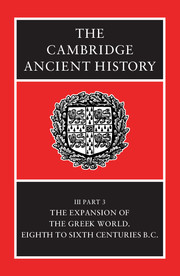Book contents
- Frontmatter
- Contents
- List of maps
- List of text-figures
- Preface
- 36a The Greeks in the Near East
- 36b The Greeks in Egypt
- 36c Cyprus
- 36d The Cypriot syllabary
- 37 The colonial expansion of Greece
- 38 The western Greeks
- 39a The eastern Greeks
- 39b Crete
- 39c Cretan Laws and Society
- 39d Euboea and the Islands
- 40 Illyris, Epirus and Macedonia
- 41 Central Greece and Thessaly
- 42 The Peloponnese
- 43 The growth of the Athenian state
- 44 The Tyranny of Pisistratus
- 45a Economic and social conditions in the Greek world
- 45b The material culture of Archaic Greece
- Chronological Table
- BIBLIOGRAPHY
- Index
- References
43 - The growth of the Athenian state
Published online by Cambridge University Press: 28 March 2008
- Frontmatter
- Contents
- List of maps
- List of text-figures
- Preface
- 36a The Greeks in the Near East
- 36b The Greeks in Egypt
- 36c Cyprus
- 36d The Cypriot syllabary
- 37 The colonial expansion of Greece
- 38 The western Greeks
- 39a The eastern Greeks
- 39b Crete
- 39c Cretan Laws and Society
- 39d Euboea and the Islands
- 40 Illyris, Epirus and Macedonia
- 41 Central Greece and Thessaly
- 42 The Peloponnese
- 43 The growth of the Athenian state
- 44 The Tyranny of Pisistratus
- 45a Economic and social conditions in the Greek world
- 45b The material culture of Archaic Greece
- Chronological Table
- BIBLIOGRAPHY
- Index
- References
Summary
The unification of Attica
The Iliad speaks of the Athenians as a single people. Homeric references to them are indeed sparse and disputable: it is anomalous that the Athenian entry in the Catalogue (II. 546–56) names only Athens itself, whereas elsewhere a king's own city is followed by a string of further place-names, the places where his warriors lived. Whatever the date when this entry was composed or the reasons for its abnormality, it is further testimony to the feeling that the inhabitants of Attica were a homogeneous people with the single city of Athens as their centre. They emerged from the Dark Age with no consciousness of any internal racial difference to divide them, they spoke the same dialect, they were organized in a unitary system of tribes, and in spite of substantial local specialities they shared a common framework of rites and festivals. Of the process by which this was achieved, much necessarily remains obscure.
The Mycenaean collapse left a remnant on the Acropolis, perhaps literally beleaguered in the early stages while they still used the water supply to which access had been elaborately engineered in the thirteenth century. In eastern Attica the cemetery at Perati attests a relatively prosperous twelfth-century community whose links were not with western Attica but with other Mycenaean survivors in the Aegean (CAH II.2, 666–7). This faded away, in circumstances not now discoverable, and the occupation of the Acropolis also came to an end. Though the development through sub-Mycenaean to Protogeometric shows that there was no sharp cultural break but a continuous process, the Mycenaean way of life had finally ceased.
- Type
- Chapter
- Information
- The Cambridge Ancient History , pp. 360 - 391Publisher: Cambridge University PressPrint publication year: 1982
References
- 17
- Cited by



